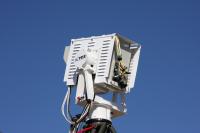Dec 14 2009
AOptix Technologies, Inc., (AOptix)a leading edge developer of ultra-high bandwidth laser communication solutions, disclosed today the completion of a two-phase flight test program for the United States Air Force Research Laboratory (AFRL) located in Rome, New York, with funding provided by the Air Force Office of Scientific Research in Arlington, Va.
 In this image, an AOptix LCT-5 lasercom terminal ground node tracks the airplane
In this image, an AOptix LCT-5 lasercom terminal ground node tracks the airplane
The flight tests were conducted as part of the Enhanced Air-to-Ground Lasercom System (EAGLS) Program, and demonstrated AOptix's unique capabilities in Pointing, Acquisition, and Tracking (PAT) along with ultra-high bandwidth real-time communications between their aircraft-mounted R3.1 Lasercom terminal and LCT-5 fixed-ground Lasercom terminal.
Flying at an altitude of approximately 12,000ft above ground level (AGL), and with a slant distance of more than 100 kilometers, AOptix successfully demonstrated a low-power, eye-safe, ultra-high bandwidth air-to-ground Free Space Optical (FSO) link. Covering an effective ground area of more than 31,000 square kilometers, the single bi-directional 2.5 Gbps multi-channel data link transmitted live simultaneous uncompressed high-definition (HD) video from two different airplane cameras and gigabit Ethernet. AOptix also demonstrated advanced error correction capabilities in Automatic Clock Recovery (ACR) and Forward Error Correction (FEC) techniques developed specifically for an ultra-high bandwidth FSO link.
"Our defense lasercom products deliver critically needed optical bandwidth for the war fighter" says Dean Senner, President and CEO of AOptix Technologies. "In- theater operations requiring real-time dissemination of persistent Intelligence, Surveillance, and Reconnaissance (ISR) information are no longer limited by the data rate constraints of today's radio frequency (RF) networks."
The AOptix wireless bi-directional optical terminals utilize a unique patented, single aperture, adaptive optics method of beam control to compensate for real-time atmospheric turbulence while maintaining lock between two terminals. Video, voice and data is transmitted through the air over a single invisible, low power, eye-safe, FSO laser link.